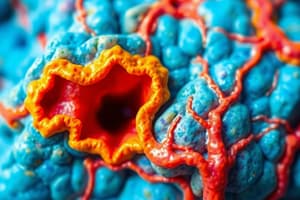Podcast
Questions and Answers
What is the primary function of epithelial tissue?
What is the primary function of epithelial tissue?
- Propagates electrical impulses
- Stores energy
- Covers exposed surfaces and lines internal passageways (correct)
- Contracts to produce movement
Which type of tissue is primarily responsible for contraction and movement?
Which type of tissue is primarily responsible for contraction and movement?
- Nervous tissue
- Connective tissue
- Epithelial tissue
- Muscle tissue (correct)
Which tissue type is involved in storing energy?
Which tissue type is involved in storing energy?
- Epithelial tissue
- Nervous tissue
- Muscle tissue
- Connective tissue (correct)
What function is primarily associated with nervous tissue?
What function is primarily associated with nervous tissue?
How do tissues combine to form organs?
How do tissues combine to form organs?
Which tissue type provides structural support in the body?
Which tissue type provides structural support in the body?
What is the relationship between tissues, organs, and organ systems?
What is the relationship between tissues, organs, and organ systems?
Which statement correctly describes connective tissue?
Which statement correctly describes connective tissue?
What is the primary function of synovial fluid?
What is the primary function of synovial fluid?
Which protein filaments interact to enable muscle contraction?
Which protein filaments interact to enable muscle contraction?
What characteristic distinguishes skeletal muscle tissue from cardiac and smooth muscle tissues?
What characteristic distinguishes skeletal muscle tissue from cardiac and smooth muscle tissues?
What creates the striated appearance in skeletal muscle fibers?
What creates the striated appearance in skeletal muscle fibers?
Which type of muscle tissue is primarily controlled by the nervous system?
Which type of muscle tissue is primarily controlled by the nervous system?
Which of the following locations is NOT associated with smooth muscle tissue?
Which of the following locations is NOT associated with smooth muscle tissue?
What is a characteristic feature of smooth muscle cells?
What is a characteristic feature of smooth muscle cells?
What is the primary function of smooth muscle tissue?
What is the primary function of smooth muscle tissue?
Where is nervous tissue most concentrated?
Where is nervous tissue most concentrated?
What is one major function of nervous tissue?
What is one major function of nervous tissue?
Which of the following statements about smooth muscle tissue is true?
Which of the following statements about smooth muscle tissue is true?
Smooth muscle tissue regulates the diameter of which structures?
Smooth muscle tissue regulates the diameter of which structures?
What characteristic distinguishes involuntary muscle from voluntary muscle?
What characteristic distinguishes involuntary muscle from voluntary muscle?
What type of connective tissue is characterized by fibers that are loosely packed?
What type of connective tissue is characterized by fibers that are loosely packed?
Which type of cartilage provides stiff but somewhat flexible support and reduces friction between bony surfaces?
Which type of cartilage provides stiff but somewhat flexible support and reduces friction between bony surfaces?
In which locations can elastic cartilage be found?
In which locations can elastic cartilage be found?
What function does fibrocartilage serve?
What function does fibrocartilage serve?
Which type of connective tissue contains a solid, rubbery matrix?
Which type of connective tissue contains a solid, rubbery matrix?
What characterizes fluid connective tissues?
What characterizes fluid connective tissues?
Which type of connective tissue proper has densely packed fibers?
Which type of connective tissue proper has densely packed fibers?
Where is hyaline cartilage primarily located?
Where is hyaline cartilage primarily located?
What type of connective tissue is NOT considered a type of supporting connective tissue?
What type of connective tissue is NOT considered a type of supporting connective tissue?
What is the primary function of serous fluid in relation to serous membranes?
What is the primary function of serous fluid in relation to serous membranes?
What is the primary function of blood as a fluid connective tissue?
What is the primary function of blood as a fluid connective tissue?
Which type of epithelial tissue composes the cutaneous membrane?
Which type of epithelial tissue composes the cutaneous membrane?
What is a characteristic of synovial membranes?
What is a characteristic of synovial membranes?
What type of connective tissue primarily composes synovial membranes?
What type of connective tissue primarily composes synovial membranes?
Which of the following correctly describes the cutaneous membrane?
Which of the following correctly describes the cutaneous membrane?
What role does articular cartilage play in relation to synovial membranes?
What role does articular cartilage play in relation to synovial membranes?
What type of connective tissue is found beneath the skin in the cutaneous membrane?
What type of connective tissue is found beneath the skin in the cutaneous membrane?
Which of the following statements about parietal and visceral membranes is true?
Which of the following statements about parietal and visceral membranes is true?
Flashcards are hidden until you start studying
Study Notes
Tissues
- Tissues are groups of similar cells that work together to perform a specific function
- Tissues combine to form organs
- Organs work together in organ systems
Types of tissues
- Epithelial tissue covers exposed surfaces, lines internal passageways, and produces glandular secretions.
- Connective tissue fills internal spaces, provides structural support, stores energy, and transports substances.
- Muscle tissue contracts to produce active movement.
- Nervous tissue transmits electrical impulses to rapidly sense the internal and external environment, processing information and controlling responses.
Connective tissue types
- Connective tissue proper
- Loose fibers are loosely packed, creating an open framework
- Dense fibers are densely packed
- Fluid connective tissues
- Blood flows within the cardiovascular system
- Lymph flows within the lymphatic system
- Supporting connective tissues
- Cartilage is solid and rubbery
- Bone is solid and crystalline
Cartilage types
- Hyaline Cartilage is the most common type, found in the nose, trachea, and ribs. It provides stiff but flexible support and reduces friction.
- Elastic Cartilage is found in the ears and epiglottis. It is more flexible than hyaline cartilage and can return to its original shape after distortion.
- Fibrocartilage is found in the intervertebral discs and menisci of the knee. It is the strongest type of cartilage and resists compression.
Membranes
- Serous membranes line body cavities and cover organs. They are composed of a thin layer of epithelium and connective tissue.
- Parietal layer lines the inner surface of the cavity.
- Visceral layer covers the outer surface of organs.
- Serous fluid reduces friction between the layers.
- **Cutaneous membrane ** is the skin. It is made of stratified squamous epithelium and connective tissue. It is thick, waterproof, and usually dry.
- Synovial Membranes line joint cavities and are composed of areolar connective tissue and a thin epithelial layer. They produce synovial fluid, which lubricates the joint and allows smooth movement.
Muscle Tissue
- Specialized for contraction.
- Composed of long, slender cells called muscle fibers.
- Contraction is due to interactions between filaments of myosin and actin proteins.
- Can be voluntarily controlled or primarily controlled by the nervous system (involuntary).
Types of Muscle Tissue
- Skeletal muscle tissue is striated and voluntary.
- Smooth muscle tissue is nonstriated and involuntary. It is found in the walls of blood vessels, hollow organs, and the digestive, respiratory, urinary, and reproductive tracts.
- Cardiac muscle tissue is found only in the heart. It is striated and involuntary.
Nervous Tissue
- Specialized for transmitting electrical impulses.
- Most concentrated in the brain and spinal cord.
- Rapidly senses internal or external environment.
- Processes information and controls responses.
Studying That Suits You
Use AI to generate personalized quizzes and flashcards to suit your learning preferences.



